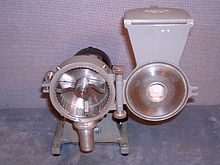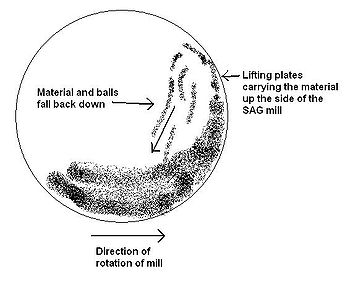- Mill (grinding)
-
Mill 
A tabletop hammer millOther names Grinding mill Uses Grinding Related items Mortar and pestle
Expeller
ExtruderA grinding mill is a unit operation designed to break a solid material into smaller pieces. There are many different types of grinding mills and many types of materials processed in them. Historically mills were powered by hand (mortar and pestle), working animal (horse mill), wind (windmill) or water (watermill). Today they are also powered by electricity.
The grinding of solid matters occurs under exposure of mechanical forces that trench the structure by overcoming of the interior bonding forces. After the grinding the state of the solid is changed: the grain size, the grain size disposition and the grain shape.
Grinding may serve the following purposes in engineering:
- increase of the surface area of a solid
- manufacturing of a solid with a desired grain size
- pulping of resources
Contents
Grinding laws
In spite of a great number of studies in the field of fracture schemes there is no formula known which connects the technical grinding work with grinding results. To calculate the needed grinding work against the grain size changing three half-empirical models are used. These can be related to the Hukki relationship between particle size and the energy required to break the particles. In stirred mills, the Hukki relationship does not apply and instead, experimentation has to be performed to determine any relationship.[1]
- Kick for d > 50 mm
- Bond[2] for 50 mm > d > 0.05 mm
- Von Rittinger for d < 0.05 mm
with W as grinding work in kJ/kg, c as grinding coefficient, dA as grain size of the source material and dE as grain size of the ground material.
A reliable value for the grain sizes dA and dE is d80. This value signifies that 80% (mass) of the solid matter has a smaller grain size. The Bond's grinding coefficient for different materials can be found in various literature. To calculate the KICK's and Rittinger's coefficients following formulas can be used


with the limits of Bond's range: upper dBU = 50 mm and lower dBL = 0.05 mm.
To evaluate the grinding results the grain size disposition of the source material (1) and of the ground material (2) is needed. Grinding degree is the ratio of the sizes from the grain disposition. There are several definitions for this characteristic value:
- Grinding degree referring to grain size d80

- Instead of the value of d80 also d50 or other grain diameter can be used.
- Grinding degree referring to specific surface
- The specific surface area referring to volume Sv and the specific surface area referring to mass Sm can be found out through experiments.
- Pretended grinding degree

- The discharge die gap a of the grinding machine is used for the ground solid matter in this formula.

Grinding machines
In materials processing a grinder is a machine for producing fine particle size reduction through attrition and compressive forces at the grain size level. See also crusher for mechanisms producing larger particles. In general, grinding processes require a relatively large amount of energy; for this reason, an experimental method to measure the energy used locally during milling with different machines was recently proposed.[3]
 Operation of a ball mill
Operation of a ball mill
Ball mill
A typical type of fine grinder is the ball mill. A slightly inclined or horizontal rotating cylinder is partially filled with balls, usually stone or metal, which grinds material to the necessary fineness by friction and impact with the tumbling balls. Ball mills normally operate with an approximate ball charge of 30%. Ball mills are characterized by their smaller (comparatively) diameter and longer length, and often have a length 1.5 to 2.5 times the diameter. The feed is at one end of the cylinder and the discharge is at the other. Ball mills are commonly used in the manufacture of Portland cement and finer grinding stages of mineral processing. Industrial ball mills can be as large as 8.5 m (28 ft) in diameter with a 22 MW motor,[4] drawing approximately 0.0011% of the total world's power (see List of countries by electricity consumption). However, small versions of ball mills can be found in laboratories where they are used for grinding sample material for quality assurance.
The power predictions for ball mills typically use the following form of the Bond equation:[2]
where
- E is the energy (kilowatt-hours per metric or short ton)
- Wi is the work index measured in a laboratory ball mill (kilowatt-hours per metric or short ton)
- P80 is the mill circuit product size in micrometers
- F80 is the mill circuit feed size in micrometers.
Rod mill
A rotating drum causes friction and attrition between steel rods and ore particles.[citation needed] But note that the term 'rod mill' is also used as a synonym for a slitting mill, which makes rods of iron or other metal. Rod mills are less common than ball mills for grinding minerals.
Autogenous mill
Autogenous mills are so-called due to the self-grinding of the ore: a rotating drum throws larger rocks of ore in a cascading motion which causes impact breakage of larger rocks and compressive grinding of finer particles. It is similar in operation to a SAG mill as described below but does not use steel balls in the mill. Also known as ROM or "Run Of Mine" grinding.
SAG mill
SAG is an acronym for Semi-Autogenous Grinding. SAG mills are essentially autogenous mills, but utilize grinding balls to aid in grinding like in a ball mill. A SAG mill is generally used as a primary or first stage grinding solution. The SAG mills use a minimal ball charge of 6 to 15%. SAG mills can be as large as 42' in diameter, with up to a 28 MW motor.
Attrition in the grinding balls causes grinding of finer particles. SAG mills are characterized by their large diameter and short length as compared to ball mills. The inside of the mill is lined with lifting plates to lift the material inside up and around the inside of the mill, where it then falls off the plates into the rest of the ore. SAG mills are primarily used in the gold, copper and platinum industries with applications also in the lead, zinc, silver, alumina and nickel industries.
Pebble mill
A rotating drum causes friction and attrition between rock pebbles and ore particles. May be used where product contamination by iron from steel balls must be avoided.
High pressure grinding rolls
In high pressure grinding rolls, often referred to as HPGRs, the ore is fed between two rollers which are pushed firmly together while their rotating motion pushes the ore through a small gap between them. Extreme pressure causes the rocks to fracture into finer particles and also causes microfracturing at the grain size level. HPGRs are often considered as being more efficient than grinding mills, although they are not as common as grinding mills since they are a newer technology.
HPGRs consist of a pair of horizontal cylindrical rollers through which material is passed. The two rollers rotate in opposite directions, "nipping" and crushing material between them. A similar type of intermediate crusher is the edge runner, which consists of a circular pan with two or more heavy wheels known as mullers rotating within it; material to be crushed is shoved underneath the wheels using attached plow blades.
Buhrstone mill
Another type of fine grinder commonly used is the buhrstone mill, which is similar to old-fashioned flour mills.
Vertical shaft impactor mill (VSI mill)
Type of fine grinder which uses a free impact of rock or ore particles with a wear plate. High speed of the motion of particles is achieved with a rotating accelerator. This type of mill uses the same principle as VSI Crusher
Tower mill
Tower mills, often called vertical mills, stirred mills or regrind mills, are a more efficient means of grinding material at smaller particle sizes, and can be used after ball mills in a grinding process. Like ball mills, grinding balls are often added to stirred mills to help grind ore, however these mills contain a large screw mounted vertically to lift and grind material. In tower mills, there is no cascading action as in standard grinding mills. Stirred mills are also common for mixing quicklime (CaO) into a lime slurry.
Vibratory mill
Types of grinding mills
- windmill, wind powered
- watermill, water powered
- horse mill, animal powered
- treadwheel, human powered (archaic: "treadmill")
- ship mill, floats near a river bank or bridge
- roller mill, an equipment for the grinding or pulverizing of grain and other raw materials using cylinders
- Stamp mill, a specialized machine for reducing ore to powder for further processing or for fracturing other materials
- a place of business for making articles of manufacture. The term mill was once in common use for a factory because many factories in the early stages of the Industrial Revolution were powered by a watermill, but nowadays it is only used in a few specific contexts; e.g.,
- bark mill produces tanbark for tanneries
- cider mill crushes apples to give cider
- gristmill grinds grain into flour
- oil mill, see expeller pressing, extrusion
- paper mill produces paper
- sawmill cuts timber
- starch mill
- steel mill manufactures steel
- sugar mill (also called a sugar refinery) processes sugar beets or sugar cane into various finished products
- textile mill (disambiguation)
- silk mill, for silk
- flax mill, for flax
- cotton mill, for cotton
- huller (also called a rice mill, or rice husker) is used to hull rice
- powder mill produces gunpowder
- Ball mill
- Colloid mill
- Conical mill
- Disintegrator
- Disk mill
- Edge mill
- Gristmill, also called flour mill or corn mill
- Hammer mill
- Jet mill
- Mortar and pestle
- Pellet mill
- Planetary mill
- Stirred mill
- Vibratory mill
- VSI mill
- Wiley mill
- Windmill
See also
- Burr grinder
- Coffee grinder
- Expeller
- Extruder
- Grist mill
- Herb grinder
- Millstone
- Rock crusher
References
- ^ Thomas, A; Filippov, L.O. (1999). "Fractures, fractals and breakage energy of mineral particles". International Journal of Mineral Processing 57 (4): 285. doi:10.1016/S0301-7516(99)00029-0.
- ^ a b Mineral Beneficiation – The Third Theory of Comminution – Document Summary. Onemine.org. Retrieved on 2010-10-09.
- ^ Baron, M.; Chamayou, A.; Marchioro, L.; Raffi, J. (2005). "Radicalar probes to measure the action of energy on granular materials". Advanced Powder Technology 16 (3): 199. doi:10.1163/1568552053750242.
- ^ "ABB". ABB Communications. ABB Communications. http://www.abb.com/cawp/seitp202/8231666baa1c0a45c1257842002fe89b.aspx.
External links
Categories:- Grinding mills
- Mining equipment
Wikimedia Foundation. 2010.






